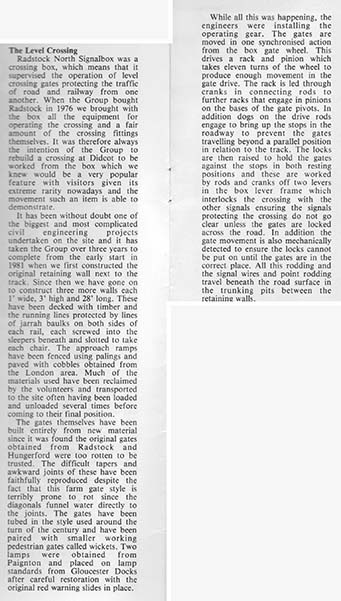Great Western Echo — No.89. Spring 1985 pp.6-7
‘The Level Crossing’ by Alan Price
© Great Western Society

Radstock North Signalbox was a crossing box, which means that it supervised the operation of level crossing gates protecting the traffic of road and railway from one another. When the Group bought Radstock in 1976 we brought with the box all the equipment for operating the crossing and a fair amount of the crossing fittings themselves. It was therefore always the intention of the Group to rebuild a crossing at Didcot to be worked from the box which we knew would be a very popular feature with visitors given its extreme rarity nowadays and the movement such an item is able to demonstrate.
It has been without doubt one of the biggest and most complicated civil engineering projects undertaken on the site and it has taken the Group over three years to complete from the early start in 1981 when we first constructed the original retaining wall next to the track. Since then we have gone on to construct three more walls each 1' wide, 3' high and 28' long. These have been decked with timber and the running lines protected by lines of jarrah baulks on both sides of each rail, each screwed into the sleepers beneath and slotted to take each chair. The approach ramps have been fenced using palings and paved with cobbles obtained from the London area. Much of the materials used have been reclaimed by the volunteers and transported to the site often having been loaded and unloaded several times before coming to their final position.
The gates themselves have been built entirely from new material since it was found the original gates obtained from Radstock and Hungerford were too rotten to be trusted. The difficult tapers and awkward joints of these have been faithfully reproduced despite the factthat this farm gate style is terribly prone to rot since the diagonals funnel water directly to the joints. The gates have been tubed in the style used around the turn of the century and have been paired with smaller working pedestrian gates called wickets. Two lamps were obtained from Paignton and placed on lamp standards from Gloucester Docks after careful restoration with the original red warning slides in place.
While all this was happening, the engineers were installing the operating gear. The gates are moved in one synchronised action from the box gate wheel. This drives a rack and pinion which takes eleven turns of the wheel [Sic. Actually one turn of the wheel is sufficient] to produce enough movement in the gate drive. The rack is led through cranks in connecting rods to further racks that engage in pinions on the bases of the gate pivots. In addition dogs on the drive rods engage to bring up the stops in the roadway to prevent the gates travelling beyond a parallel position in relation to the track. The locks are then raised to hold the gates against the stops in both resting positions and these are worked by rods and cranks off two levers in the box lever frame which interlocks the crossing with the other signals ensuring the signals protecting the crossing do not go clear unless the gates are locked across the road. In addition the gate movement is also mechanically detected to ensure the locks cannot be put on until the gates are in the correct place. All this rodding and the signal wires and point rodding travel beneath the road surface in the trunking pits between the retaining walls.
To return to the History Page - Simply close this window